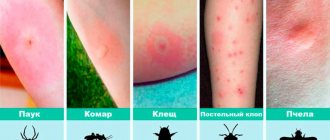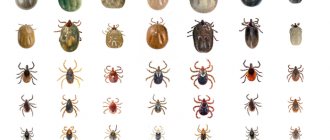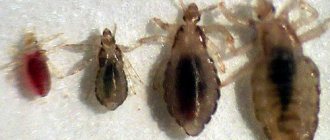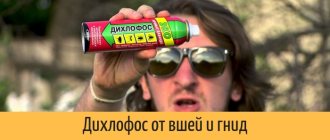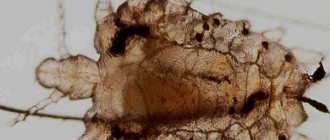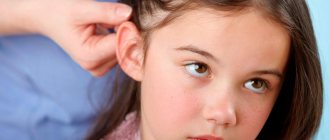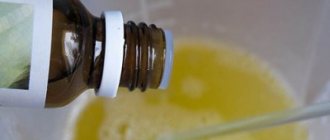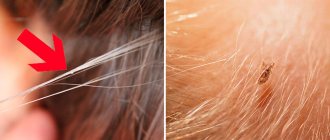What do bites look like?
One of the “signposts” of an unpleasant neighborhood is the detection of traces of insects. For this reason, it is important to know exactly what the skin lesions left by linen, bed and body lice look like.
Believykh
Linen lice bites are localized in areas of slight hair growth - lower back, buttocks, neck, upper back, abdomen. During the feeding process, the insect moves throughout the human body, moving away from the previous site of the lesion. For this reason, traces of pests are located in groups, but do not form a “path”.
The site of the skin lesion turns red and swells. When in contact with items of clothing, the spots begin to itch. When scratched, they become dense and ulcers appear.
The wounds take a long time to heal. Unlike an allergic rash, the redness of the skin does not subside after using antihistamines. To get a good look at what a bite from linen lice looks like on the body, you should arm yourself with a magnifying glass - this is a common spot on the skin with a black mark in the middle.
Video
What do bed bug bites look like?
Bed
The bed louse is not interested in the hair area of the human body. Unlike its relatives (pubic and hairy individuals), the bed parasite is larger in size - 3-5 mm.
Most bed lice bites occur in the armpits, on the hips and lower back, between the shoulder blades, and on the neck . The lesions are not localized in a specific way; they are located chaotically and are presented as single swellings with a dot in the center.
After saturation, the parasite turns red-brown, increases in size and begins to resemble a flea.
Clothes
Body lice bites cluster around the neck, waist, upper back, armpits, groin and abdomen. Externally, the affected area is similar to a bed lice mark. Over time, single spots on the body become bluish.
How dangerous are linen lice?
Despite their tiny size, body lice pose a serious threat to humans. Together with the saliva of the parasite, deadly infections of typhus and relapsing louse typhus, as well as Volyn fever, can enter the bloodstream.
A person affected by pests, if there are a lot of insects or they parasitize on him for a long time, may develop body lice (which was already mentioned above). This disease is characterized by thickening and hardening of the skin in the area of the shoulder blades, shoulders, lower back and inner thighs. White scars may also appear in the affected areas. As a consequence of the bite, furunculosis often occurs and purulent wounds form.
How lice bite
Answering the question of how bed lice bite, you can give a similar answer to the question regarding other types of insects. The principle is identical : the parasite’s mouth is made up of jaws that resemble stilettos.
By biting, the louse pierces the skin with the help of its jaws and injects a little enzyme into the resulting wound, which prevents human blood from clotting. It is this substance that causes irritation, itching and redness at the site of the lesion.
Once the integrity of the skin is broken, the insect begins to search for an artery, which will become a source of nutrition. The pest sucks, clinging as closely as possible to the human body - its back part rises slightly.
The adult repeats the meal every 2-3 hours. After finding out how linen lice bite a person, it is worth moving on to the logical section on the correct treatment of lesions.
Products for treating bites
In most cases, you can cope with the symptoms of an insect attack on your own. The help of a specialist is necessary if a clear allergic reaction occurs - a person’s temperature rises, chills, headache, nausea, etc.
As part of the question of how to treat lice bites from linen, bed and clothing lice, it makes sense to consider the features of the use of medicines and folk remedies
Medicines
At home, parasite stains can be treated as follows::
- any ointment containing hydrocortisone (relieves swelling and discomfort after a bite);
- hydrogen peroxide (has antiseptic properties);
- homeopathic medicines (with tea tree oil, calendula);
- Fenistil gel (relieves severe itching).
If the patient develops purulent formations indicating the development of an infection, the patient may require antibiotic therapy (Doxycycline, Lincomycin, etc.) as prescribed by the doctor.
Other medications prescribed by the doctor include the antiseptics Miramistin, Chlorhexidine, antihistamines Zodak, Suprastin, etc.
Universal products will help you get rid of linen, bed and clothing lice.:
- Paranit;
- Pediculen;
- Para Plus and others
Folk remedies
Folk help for lice bites is also appropriate.
Among the possible “helpers” in eliminating the primary symptoms of insect bites:
- soap solution. Helps relieve the first unpleasant symptoms, disinfects;
- alcohol or vodka diluted with water in a 1:1 ratio. Disinfects and prevents infection from penetrating into the deep layers of the dermis.
How to distinguish lice bites from other insect bites
Single bites of clothing, linen and bed lice are very easily confused with the site of a bite, for example, of a bedbug.
There are some "landmarks" that can help identify the pest.:
- The louse leaves behind chaotically “scattered” spots, unlike the bug. The latter tries to bite at a distance of several centimeters - a “chain” of spots is obtained.
- An insect bite differs from the lesion left by a flea in the absence of obvious pain at the time the skin is damaged. If a flea bites, this process is accompanied by intense pain. He learns that a person has been bitten by a louse several hours after contact. In addition, fleas often leave visualized “tracks” on the victim’s body.
- Ticks, unlike lice, leave behind a large area of damage (a swollen red circle). To eliminate the feeling of hunger, the tick needs to eat from several hours to several days; lice do not eat for that long.
- Mosquito bites differ from marks on the body left by lice in the absence of a darkened hole in the center in the affected area.
In some cases, insect marks are confused with manifestations of scabies, which is caused by scabies mites. However, in this case there are no visible traces of skin puncture at all.
How to avoid infection?
Preventing body lice from occurring won't be difficult if you know how it spreads and what needs to be done to prevent it from happening. For example:
- Lice can spread to another person as a result of close contact, and for quite a long time. Lice are capable of moving at a speed of 20 cm per minute, so quick contact does not threaten infection, since the parasite will not have time to move to another victim.
- Infestation with body lice can occur in crowded places. For example, this could be public transport, when people come into contact with each other for a long time and this time is enough for lice to move to another person.
- Preschool institutions and schools, especially junior grades, are also not an exception. As a rule, children are in contact with each other, regardless of the appearance of children or classmates.
- Such breeding grounds include spontaneous markets (flea markets), where used clothing is offered. Such clothing must be treated appropriately immediately.
If you know how these parasites spread, you can protect yourself from them by staying away from groups of people. Of course, in some cases it is simply impossible to do this, for example, during rush hour, but then you need to inspect your clothes upon arrival home. When entering an apartment, it is better to shake it off on the landing.
Danger of bites
The danger of bites from linen and other types of lice lies in the likelihood of a person becoming infected with dangerous diseases. The infection process takes a few seconds.
Among the pathologies carried by lice:
- relapsing fever (manifested by skin redness, intoxication of the body, attacks of fever);
- typhus (occurs against the background of destructive vascular changes);
- Volyn fever (manifests as acute pain in muscles, bones) and others.
Bites from body lice and other types of lice can also cause an acute allergic reaction, which in some cases leads to anaphylactic shock - the patient needs urgent medical attention.
For this reason, if suspicious spots appear on the body, it is necessary to promptly exclude linen lice bites.
What symptoms appear and how does the patient feel?
Common signs for different types of blood-sucking parasites:
- Intense itching
- Redness on the body - bite marks
- Nits are found on the hair.
But lice bites on the head and pubic area are characterized by another common symptom - the condition of the hair worsens, it sticks together. However, this happens with severe infection, when there are too many pests, and in addition, the person ignores the rules of hygiene - does not wash his head and body.
Then so-called tangles are formed. This is the result of the work of the sebaceous and sweat glands of the head, but there is another factor - an adhesive secretion that ensures the attachment of nits to the hair, and waste products of insects that bite humans.
The patient feels severe itching when a louse bites him. If wounds appear, then pain is added. An allergic reaction manifests itself as swelling, which worsens the quality of life and poses a danger. Intense itching interferes with sleep, the person becomes irritable.
Preventive measures
Preventing the spread of lice involves regularly checking suitcases upon returning from a business trip or traveling, and washing stale items of clothing.
To protect yourself from insects, you can put a cotton pad soaked in hellebore water or lavender oil in the closet with your linen. You should visit beauty salons and hairdressers with caution and pay attention to the disinfection of instruments.
Lice live in the folds of people's clothing, bedding and other textile household items. Pests can be detected not only visually, but also by the appearance of bites on the body of household members.
The affected areas are presented in the form of red swellings on the skin, which are characterized by a chaotic location. The bites itch, and ulcers remain at the scratch site.
Medical care for those affected by the active life of parasites should be followed by no less active pest control. You can carry out all the necessary activities yourself or contact specialists.
Fighting body lice - where to start?
It should be noted that these insects are perfectly adapted to various living conditions, so their complete destruction can take a lot of effort and time . Anyone who has encountered this problem at least once in their life knows that they should be gotten rid of in a comprehensive manner, attacking lice from all sides and not allowing them to survive and reproduce.
You should start, of course, with disinfection of all textile products that come into contact with the human body and personal hygiene procedures. It is important to remember that simple washing will not kill body lice. You should wash at a particularly high temperature, and what’s even better is to use boiling. Dry linen and clothes in the open air, after which all washed items must be ironed at the highest permissible ironing setting. Particular attention should be paid to: collars, folds, seams. These are exactly the places where bed lice like to hide.
Additionally, you should boil personal items such as hair clips, hair ties, combs and various headbands. After which it is recommended to keep them for 2-3 days in the fresh air , preferably in the open rays of the sun.
How to get rid of linen lice - folk methods
For more reliable destruction of parasites, before washing and boiling, you should treat things with a large amount of insecticides. You can also use kerosene-soap emulsion (at least 20%) or powdered pyrethrum. These preparations must be used to clean seams and joints on mattresses and pillows.
Acetic acid is rightfully considered an excellent method of disinfection . It is recommended to treat seams and joints of pillows and mattresses with a solution of acetic acid mixed with a small amount of water, as well as soak bed linen and clothes in the essence for 30-40 minutes before washing. Cranberry juice, due to its fairly strong concentration, is also an excellent solution for getting rid of linen lice.
Processing clothes and bedding in a steam-formalin chamber is guaranteed to kill all nits, larvae and adults.
It is important that as soon as you find at least some signs of body lice in your home, you should immediately begin to get rid of them and begin thoroughly treating your home. After all, these parasites have the peculiarity of extremely rapid reproduction. And of course, you should immediately take care of personal hygiene. To do this, get rid of contaminated clothing, take a shower using a hard washcloth and laundry or tar soap.



